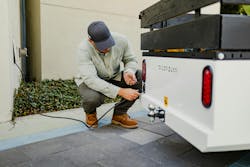Your Next Generation of Ground Vehicles Starts Today

The aviation industry is going emission-free by 2050. To help meet this ambitious goal, it’s time for airports and operators to think differently about electrifying on the ground and optimizing their operations for safety, cost, and sustainability while they do it.
About 50 percent of major airport ground support fleets are made up of trucks, tractors, vans, sedans, and carts, and are mostly internal combustion engine (ICE) vehicles. At smaller airports, that percentage is even higher. Going electric is an opportunity to optimize fleets – in size as well as how it is powered – and doesn’t need to result in a transition of the same type of ICE vehicle to a high-cost EV. For example, an ICE powered pick-up truck doesn’t need to be replaced with a full-sized electric pick-up truck. Lower cost, right sized electric alternatives like sustainable low-speed electric vehicles or industrial electric trucks are available today, easy to charge, cost-effective, safe, and sustainable.
Ground EVs to Accelerate Airport Electrification
Low-speed vehicles (LSVs) have been around for decades – becoming mainstays on corporate campuses like airports. And it’s easy to understand why. With a maximum speed of 25 mph, LSVs are street-legal, four-wheel, electric motor vehicles under federal and state law and can generally be driven on any U.S. roads posted 35 mph or slower. Their compact footprint takes up less space on crowded airports, and they are capped at a maximum weight of 3,000 lbs. Yet, LSVs are highly capable. One of the original LSVs, GEM, for example, comes in a 2-seat truck model, and 2, 4 or 6 seat passenger models, all with automotive like comfort and safety - making them a viable option for airport operations to accelerate electrification with a safe and sustainable alternative to traditional trucks, carts, sedans, and vans.
Industrial Trucks
All-electric burden carriers have been proven to support a multitude of airport tarmac operations such as baggage handling, lavatory services, potable water service and maintenance operations. In fact, airport operations professionals may find burden carriers are all that’s needed for ground support operations – easily becoming an industry mainstay, replacing trucks, maintenance vehicles and tow tractors with a single versatile vehicle. For instance, with a load capacity of 3,000 lbs and a tow capacity of up to 10,000 lbs, the Taylor-Dunn Bigfoot XL burden carrier can haul more than a standard pick-up truck, while being nimble enough for narrow turns.
Right-Sized EVs Optimize Operations
Unlike airplanes, airport vehicles are rarely allowed to travel at high speeds or for long distances. In fact, speeds across airport campuses are typically limited to 15-25 mph, making traditional full-sized vehicles an unnecessary addition and cost to airport fleets – especially with ICE vehicles operating most inefficiently and outputting the most emissions at lower operational speeds or at idle. Replacing full-size ICE vehicles with low-speed EVs across airport operations will decrease operational costs and eliminate emissions, and with the right low-speed options, without sacrificing capabilities or safety.
Golf Carts are for the Greens
Golf carts have no place on airport campuses. They are designed for the golf course, not for a bustling industrial environment like an airport, and thus, safety features are often lacking. Instead, airports should look for EVs – such as LSVs – that are capable enough to meet the operational needs and are built with safety features such as three-point seat belts, back-up cameras, noise emitters, turn signals and solid door cabs.
Long-Range Vehicles are for Road Trips
Airport vehicles require less range than highway vehicles and fleets can optimize to that. With the right-sized vehicle for the application, there will be more efficient vehicles across the airport, pulling less power from the grid, and providing a more cost-effective solution for operators. While vehicle range will fluctuate based on payload, climate and driving conditions, 40-60 miles of range between charges is typically more than sufficient for airport operations. Where more range is needed, lithium-ion (Li-ion) battery options will provide greater flexibility. Solar panels can also be incorporated into EVs, such as GEMs, for extended drive time between charges.
Larger Vehicles Add to Ramp Traffic
GEM LSVs and Bigfoot industrial trucks provide all the needed capability in a compact footprint that takes up less space on the ramp. This means equipment that can be parked in less space and smaller to avoid accidents during a turn. And with more free space to move, everyone is more efficient.
Wrong Vehicles for the Job = Wrong Cost for Operators
EVs are one of the lowest total cost vehicles to own and operate. For example, operations save on average $20,836 when deploying an electric GEM eL XD vs. an internal combustion vehicle. EVs also require far less maintenance and repairs than an internal combustion engine, due to fewer moving parts, further increasing uptime and profits. When opting for small-scale, low-speed electric vehicles, the cost savings can be even more abundant – with smaller form-factor EVs often costing less to acquire and requiring less power than full-size EVs.
For even greater savings and productivity, consider EVs with Li-ion battery options. Advanced Li-ion batteries provide at least 3,000 cycles and the greatest efficiency without power loss as the battery charge depletes. Li-ion batteries last significantly longer than flooded lead-acid or AGM batteries – up to five times as long – contributing to an even lower total cost of ownership. Li-ion batteries also don’t require maintenance such as posts to be cleaned or fluid to be monitored or added, making them more reliable and further increasing uptime and saving overall costs. Bigfoot Li-ion Burden Carrier, for example, can see more than $10,000 in battery lifetime savings alone. Additionally, look for lithium power modules that use LiFePO4 cells which is known to be one of the most stable chemistries in the battery industry. At the end of the serviceable life of power modules with LiFePO4 cells, the cells can be utilized for energy storage in things such as power walls and off-grid power sources.
Electrify Ground Fleets Now–Infrastructure Optional
Avoiding full-size EVs also eliminates up-front charging and infrastructure requirements. With flexible charging and battery options, LSVs like GEM and industrial trucks like Taylor-Dunn Bigfoots can adapt to a wide range of infrastructure readiness – breaking down adoption barriers and simplifying the transition. Infrastructure requirements can scale with the fleet, starting with as little as dedicated 110v-240v single phase outlets up to fast charging options. For example, GEM, and Bigfoot industrial trucks can plug into the same outlet as a smart phone for easy overnight charging that require no immediate infrastructure changes.
Net-zero by 2050 is ambitious, but going electric is attainable for the majority of ground vehicles today. By making the transition from full-size ICE to right-sized EVs, airports can eliminate emissions from their operations vehicles while also enhancing safety, vehicle capabilities and operational productivity. With electric burden carriers and LSVs that can do more with less and use the same charging infrastructure, airports can replace gas and unnecessary full-sized electric cars, vans, shuttles, and carts with a more streamlined, cost-efficient fleet that meets sustainability today and well into the future.
About the Author

Gerry Hoadley
Gerry Hoadley is the director of ground support equipment (GSE) business at Waev Inc., an electric mobility provider founded in 2021 to manufacture, distribute, market and support the GEM, Taylor-Dunn and Tiger brands. In this position, Hoadley leads product and business development, customer sales and service for the Tiger tow tractor vehicle line.